A new report from the Congressional Research Service details lawmakers’ potential concerns over the Marine Corps’ plan to redesign its force by 2030, including questions on reducing the required number of F-35s and eliminating its tank battalions.
The document previews the scrutiny Gen. David Berger, the Marine Corps commandant, will likely face from Congress as he looks to implement his vision of retooling toward naval expeditionary warfare and building a lighter force capable of meeting future challenges against peer competitors such as China.

“Congress in its regulatory, oversight, and authorization and appropriations roles could take interest in this major proposed force design initiative,” wrote the authors of the report.
The Marine Corps’ force design plan, which was released in March, includes completely divesting from tank battalions, downsizing the number of infantry battalions from 24 to 21, artillery cannon batteries from 21 down to 5, amphibious vehicle companies from 6 to 4 and reducing all tiltrotor, attack and heavy lift squadrons (Defense Daily, March 24).
The report states the elimination of tank battalions “represents a significant reduction in the ability to confront enemy armor threats,” and notes “the estimated elimination of 76% of the Marine Cannon Artillery Batteries represents a significant reduction in organic on-shore artillery fire support.”
For both areas, the report asks how the Marine Corps plans to address the loss in tank and cannon artillery capability.
The Marine Corps’ force redesign would also include reducing the number of F-35B and C aircraft per squadron from 16 to 10 platforms, as well as potentially cutting the number of required Joint Light Tactical Vehicles.
“The reduction of F-35s per squadron and the possible reduction in JLTVs resulting from unit eliminations/deactivations have implications beyond the Marines, as both are major Joint Service programs. How might this planned reduction in Marine requirements for F-35s and JLTVs affect the other military services procurement plans for these systems?” the report asks.
The report also seeks to address how the Marine Corps’ implementation of the redesign will align with current and future Navy efforts.
“How do proposed Marine force design changes and intended future capabilities efforts (e.g., long-range fires, smaller infantry battalions) fit into the larger context of changes in Navy and Marine Corps operational concepts and Navy fleet architecture, including the amphibious fleet?” the report’s authors wrote.